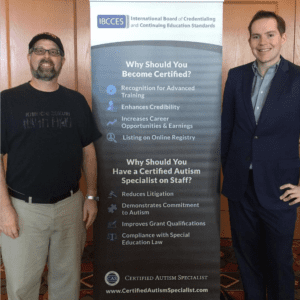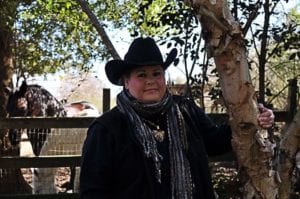 IBCCES Board Member Dr. Stephen Mark Shore rang in Autism Awareness on the Nasdaq bell Thursday, April 6 to celebrate April’s Autism Awareness Month. Congratulations Dr. Shore!
IBCCES Board Member Dr. Stephen Mark Shore rang in Autism Awareness on the Nasdaq bell Thursday, April 6 to celebrate April’s Autism Awareness Month. Congratulations Dr. Shore!
APR
 IBCCES Board Member Dr. Stephen Mark Shore rang in Autism Awareness on the Nasdaq bell Thursday, April 6 to celebrate April’s Autism Awareness Month. Congratulations Dr. Shore!
IBCCES Board Member Dr. Stephen Mark Shore rang in Autism Awareness on the Nasdaq bell Thursday, April 6 to celebrate April’s Autism Awareness Month. Congratulations Dr. Shore!
 By Donna Sigurðardóttir, founder of I am UNIK
By Donna Sigurðardóttir, founder of I am UNIKMy daughter’s future is bright. She is thriving at school because they are meeting her every need with an admirable flexibility, thoughtfulness and respect. All of which has been achieved with close cooperation between home and school, something that I believe are key factors in improving a child’s quality of life. Why? Because, on one hand we have the child’s parents, who are experts in the child and on the other hand we have the teacher, which is an expert in teaching methods and goal setting. When these two respect each others roles and take the time to listen and work together, magic happens!
Our teacher’s mentality is priceless. They have so much respect for my daughter and they put every effort in customizing her curriculum and learning environment to her needs. As an example I could mention that she always arrives late for school. Is that okay? Imagine this; she arrives into an empty school building and is exposed to minimum sensory input, which means that her stress levels are low and she gets a good start of the day. Otherwise it would take her teachers about an hour to unwind her after a chaotic school start and a maximum sensory input. That kind of a solution requires flexible thinking and caring.
 By Kerry Magro, Self-Advocate, National Speaker, and Author
By Kerry Magro, Self-Advocate, National Speaker, and AuthorI’ve written many articles about how the lack of having a peer role model growing up on the spectrum affected me. I didn’t know about Dr. Temple Grandin and others who had autism that I could look upon to show me how far I could go. As I reached adulthood though I learned about advocates such as Dr. Grandin, Carly Fleischmann, Alexis Wineman, John Elder Robison, Amy Gravino, Jesse Saperstein, the list goes on and on.
One person though who I particularly look up to is none other than international speaker Dr. Stephen Shore. Stephen Shore is not only a dear friend but also one of the biggest role models I currently have in my life.
 When I first met Stephen it was at an Autism Society of America conference. He immediately befriended me and wanted to get to know me better. After our first meeting I’d go on to read several of his books and later would be able to contribute a chapter to a book he co-authored called College for Students with Disabilities: We Do Belong. I to this day use his quote “if you’ve met one individual with autism, you’ve met one individual with autism” in a majority of my presentations. It shows how wide and unique our spectrum truly is.
When I first met Stephen it was at an Autism Society of America conference. He immediately befriended me and wanted to get to know me better. After our first meeting I’d go on to read several of his books and later would be able to contribute a chapter to a book he co-authored called College for Students with Disabilities: We Do Belong. I to this day use his quote “if you’ve met one individual with autism, you’ve met one individual with autism” in a majority of my presentations. It shows how wide and unique our spectrum truly is.
Another quote which I enjoy from Stephen is on his website where he mentions the “unlimited potential for people on the autism spectrum.” What a wonderful message. I think that’s something our entire community wants to see for our loved ones.
Now even years later it’s been astonishing to see how many times our paths have crossed. Although we are only a trade ride away from each other, me being from New Jersey and Stephen teaching in New York at Adelphi University, we still end up running into each other around the world speaking at different events. Most recently, our paths even crossed at ISCRD 2017 hosted by IBCCES in St. Augustine, Florida.
 By Anita Lesko, BSN, RN, MS, CRNA
By Anita Lesko, BSN, RN, MS, CRNA
I have the good fortune to be a friend of Dr. Temple Grandin. We have a lot in common. We are both autistic, and we share a very similar youth that played a big factor in our adult life. We both started having jobs at a very early age. Temple often talks about her early days, when her job was to greet guests at the door for her mom’s dinner party, and take their coats to hang up. Yes, it was a job. She was given a responsibility to carry out.
Among her numerous other childhood jobs was the one I, too, did for many years — mucking out horse stalls. In conversations with Temple on the phone, we’ve talked about those days of our teenage years spent shoveling out one stall after another. We both love horses and being around them. It was peaceful and it was also a form of therapy. In essence, it was our occupational therapy.
All the childhood jobs we did prepared us for the day when we’d start our careers. We were used to working, showing up on time, following orders from a boss, figuring out how to get a job done. It was just a regular part of our life. So, when the day came to embark into our careers, we really didn’t have to transition into anything. We were already there.
 By Kerry Magro, Self-Advocate, National Speaker, and Author
By Kerry Magro, Self-Advocate, National Speaker, and AuthorSomeone once said that ‘sarcasm is a metric for potential.’ Often at times though this is one of the hardest struggles for those with autism growing up.
A lack of sarcasm is often one of the most common characteristics of struggling with an autism diagnosis along with things such as social and communication issues, difficulties reading body language, using different tones in their voices and many more.
I remember as a young boy on the spectrum in computer class and hearing a joke that I didn’t find funny. It was a sarcastic joke by our teacher and while everyone else in the class laughed I was there completely blank. A girl looked at me after the joke had stopped like I had three heads.
 By Carol S. Weinman, Esq., Autism Legal Specialist
By Carol S. Weinman, Esq., Autism Legal Specialist
What better time to initiate a conversation about encounters with the criminal justice system than during Autism Awareness Month in April? While it may be well known that many individuals with Autism Spectrum Disorder (ASD) are victimized and bullied, it often comes as a surprise to learn that individuals with ASD are increasingly finding themselves detained in the back of a police wagon or seated in a courtroom at the defendant’s table. That’s why the demand for education and awareness on this timely topic is greater than ever before.
Written by Rachel Wise (article republished with permission)
In this article you will find 15 supportive behavior strategies for children on the autism spectrum (some strategies can be used with adults as well). Many of the strategies can also be used to help children without autism who have challenging behaviors.When caring for or working with a child with autism, a parent, teacher, or other adult may become frustrated with the child’s behavior. Behaviors can come on suddenly, last for hours, be hard to control, or make the adult scared or embarrassed.
By Taveesha Guyton, Social Worker
Being a caregiver is hard. The scheduling of medical, dental, school and after school activities and appointments is daunting. Let us not forget meal prep and clean up followed by the constant cleaning after little people who leave toys, and food everywhere. Yes, being a caregiver is difficult, and it is not easy when one is the caregiver of a child with Special Needs such as Intellectually Disabilities or Autism. Is there care for the caregiver and if so, what does care include? Here are some helpful tips to help caregivers.
 “Hand in Hand with Elayne”
“Hand in Hand with Elayne”
By Elayne Pearson, Special Needs Preparedness Specialist, CAS
Most children love Halloween, but it can be tricky―and downright scary for some. This holiday can be problematic for people with sensory issues―from the intense sights, sounds, smells, tastes, and textures bombarding them each October. If you have a child affected by a special-need, especially autism, Halloween can be a complex time. It can conjure a cauldron of concerns―resulting in amplified anxiety, increased impulsivity, deeper withdrawal, and even insomnia and nightmares. Yikes!
Over the many years with Heidi Ann (our little pumpkin with Down syndrome and autism) I learned several strategies to make this crazy/creepy holiday not only a happier one for her, but a sane one for us. My acronym “HALLOWEEN” offers options, cautions, and examples to help set a better tone.
October 26th – Rebecca Moyes, M.Ed.
Practical Strategies to Address Executive Functioning Skills in the Student with Autism
Executive functions are the cognitive tasks that allow us to plan, organize, initiate, attend to task, and regulate and monitor behavior. They are the key building blocks to learning! Until recently, not much has been known about how to address executive function disorder in children and adolescents with autism. Many times, the child’s problems were considered to be ‘just poor behavior,’ but we do know that kids with autism spectrum disorder, ADHD, and certain types of learning disabilities (including nonverbal learning disability) can all be impacted from executive function deficits. If your student or child has any of the following concerns, he may be struggling with executive function deficits:
Come and learn practical strategies for school and home that will empower your student to succeed, while capitalizing on his/her strengths.
October 27th – Jed Baker, Ph.D
All Kids Can Succeed: Effective Interventions for Behavioral and Social Challenges
Students on the autism spectrum and those with behavioral challenges often present with difficulty regulating their feelings and interacting socially. This workshop describes how to handle meltdowns and design effective behavior plans to prevent these moments and reduce frustration and anxiety. The second part of the presentation details strategies to motivate students to learn, ways to teach social skills, how to generalize skills into the natural setting and increase acceptance and tolerance from peers. Information will be imparted though lecture, interactive exercises, and video clips.